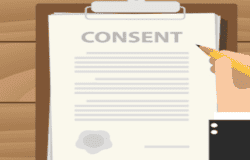As you navigate the property buying process, you will be sure to encounter plenty of paperwork along the way. One example of this is the occupier’s consent form, which will typically need to be completed by any adult who will be living in but will not be a legal owner of a property that is being bought with a mortgage.

What does this form mean?
This form is also known as an occupiers waiver form, a deed of consent, a deed of postponement, and a consent to mortgage form. The meaning and purpose remain the same: this form is designed to ensure that the person who will be living at the property being bought is fully aware of the rights the property’s mortgage provider will hold over this home. Understanding – and acknowledging – these rights is frequently set as a condition for the mortgage being granted; as such, it is usually the case that the purchase of the property cannot be completed until this document is signed and returned.
Of course, as with any legal document, it is useful to take expert advice from solicitors or conveyancers who have a full understanding of this form. A specialist concierge service, such as Sam Conveyancing can provide a quote for the independent legal advice you will need before signing and returning this form. A specialist will be able to ensure you fully comprehend the risks that come with signing a consent to mortgage form, which can include the requirement to move out of your home if the property is repossessed by the lender due to non-payment of the mortgage.
Similarly, the mortgage holder’s confirmation that they will grant the lender vacant possession in the event the lender needs to repossess their home is included in the mortgage deed.
You can find information about the repossession process, including the initial contact and the court hearing, on the Shelter website
Why it is important to lenders
Without an occupiers waiver form, mortgage lenders risk being unable to simply repossess the property should the agreed mortgage contract be breached. This is because, as an occupier of the home, you will have certain rights over the property, even if it is not owned by you. As a result, mortgage lenders are keen for prospective borrowers to ensure other residents sign a legally binding document that waives these rights, enabling them to take possession of the property if they should need to repossess it. This must be done early in the stages of agreeing a mortgage, as there can be difficulties later on if the proper process was not followed.
Who does it apply to?

Image Credit
An occupier in this case will be any person who will be living in the property who is not named on the mortgage and is not classed as a tenant. They will be over 18 years of age. The signing of the deed of consent will need to be witnessed by a neutral adult third party who is not a family member and who will not benefit from the deed in any way.
Completing the form
Unless you plan to pay for your new home without applying for a mortgage, any adult who will live with you but will not be named on the deeds or the mortgage is likely to be required to complete a consent to mortgage form when you start the process of arranging such a loan. Understanding just what is implied by signing such a document will ensure you all make the right decision for your circumstances.

